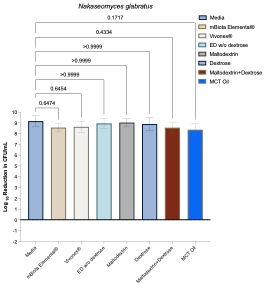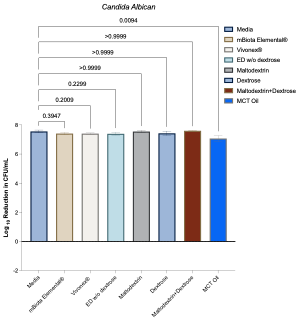Monday Poster Session
Category: Diet, Nutrition, and Obesity
P2704 - Elemental Diets Do Not Induce Fungal Overgrowth in Vitro and Reduce Fecal Candida albicans in Humans
Monday, October 27, 2025
10:30 AM - 4:00 PM PDT
Location: Exhibit Hall

Has Audio
- SM
Sepideh Mehravar, MD
Cedars-Sinai Medical Center
Los Angeles, CA
Presenting Author(s)
Sepideh Mehravar, MD1, Aida Pirvaram, MD1, Gabriela Leite, PhD2, Ruchi Mathur, MD2, Mark Pimentel, MD, FACG1, Ali Rezaie, MD, MSc1
1Cedars-Sinai Medical Center, Los Angeles, CA; 2Cedars-Sinai Medical Center, West Hollywood, CA
Introduction: Elemental diets (EDs) are complete sources of nutrition used in several gastrointestinal disorders, characterized by low fat content, free amino acids, and carbohydrates as the primary source of energy. Although EDs beneficially modulate the gut bacteriome with associated symptom improvement, their effect on gut mycobiome remains unknown. We assessed the potential for in vitro overgrowth of common pathogenic fungi when exposed to elemental diets and their key fat and carbohydrate macronutrient components. Additionally, we assessed changes in the Candida albicans before and after 2 weeks of exclusive ED from a human clinical trial (NCT05978973).
Methods: C. albicans and Nakaseomyces glabratus were cultured in Sabouraud dextrose broth (SDB) at 37°C for ~16 hours, then standardized to 10⁶ CFU/mL in PBS. 100uL of this suspension was incubated with a 100uL of two commercial elemental diets (Vivonex Plus and mBiota Elemental), a dextrose-free ED, SDB+ maltodextrin (64%), SDB+ dextrose (13%), SDB+ maltodextrin+ dextrose, SDB+MCTs and SDB alone (+control).
After incubation for 24 hours, samples were diluted, plated on SD agar and incubated at 37°C for 24–48 hrs. CFUs were then counted.
Adult subjects with microbial overgrowth (n=30) consumed 2 weeks of exclusive eucaloric oral palatable ED (mBIOTA Elemental) and were followed for 2 weeks upon reintroduction of regular diet. Stool DNA was extracted, sequenced and analyzed after PED.
Results: Neither of the EDs tested induced overgrowth of C. albicans or N. glabratus (Vivonex Plus p=0.20, p=0.64 and mBiota Elemental p=0.39, p=0.64, Figure 1 and Figure 2). Similar results were observed when C. albicans and N. glabratus were incubated with SDB supplemented with dextrose (p >0.99 and p >0.99, respectively) maltodextrin (p >0.99 and p >0.99, respectively), combination of these two sugars (p >0.99 and p=0.43, respectively, Figure 1 and 2) and dextrose-free ED (p=0.22, and p >0.99) when compared to the positive control (Figure 1 and 2). SDB+ MCT oil also appeared to modestly reduce the C. albicans growth (p=0.009).
In the human trial with PED, fecal C. albicans absolute load decreased by 3.3-fold (p = 0.04) after two weeks of the palatable ED.
Discussion: EDs and their macronutrient components do not promote fungal overgrowth in vitro and may reduce Candida burden in vivo. Further studies are needed to evaluate host-specific factors in diverse patient populations.


Disclosures:
Sepideh Mehravar, MD1, Aida Pirvaram, MD1, Gabriela Leite, PhD2, Ruchi Mathur, MD2, Mark Pimentel, MD, FACG1, Ali Rezaie, MD, MSc1. P2704 - Elemental Diets Do Not Induce Fungal Overgrowth in Vitro and Reduce Fecal <i>Candida albicans</i> in Humans, ACG 2025 Annual Scientific Meeting Abstracts. Phoenix, AZ: American College of Gastroenterology.
1Cedars-Sinai Medical Center, Los Angeles, CA; 2Cedars-Sinai Medical Center, West Hollywood, CA
Introduction: Elemental diets (EDs) are complete sources of nutrition used in several gastrointestinal disorders, characterized by low fat content, free amino acids, and carbohydrates as the primary source of energy. Although EDs beneficially modulate the gut bacteriome with associated symptom improvement, their effect on gut mycobiome remains unknown. We assessed the potential for in vitro overgrowth of common pathogenic fungi when exposed to elemental diets and their key fat and carbohydrate macronutrient components. Additionally, we assessed changes in the Candida albicans before and after 2 weeks of exclusive ED from a human clinical trial (NCT05978973).
Methods: C. albicans and Nakaseomyces glabratus were cultured in Sabouraud dextrose broth (SDB) at 37°C for ~16 hours, then standardized to 10⁶ CFU/mL in PBS. 100uL of this suspension was incubated with a 100uL of two commercial elemental diets (Vivonex Plus and mBiota Elemental), a dextrose-free ED, SDB+ maltodextrin (64%), SDB+ dextrose (13%), SDB+ maltodextrin+ dextrose, SDB+MCTs and SDB alone (+control).
After incubation for 24 hours, samples were diluted, plated on SD agar and incubated at 37°C for 24–48 hrs. CFUs were then counted.
Adult subjects with microbial overgrowth (n=30) consumed 2 weeks of exclusive eucaloric oral palatable ED (mBIOTA Elemental) and were followed for 2 weeks upon reintroduction of regular diet. Stool DNA was extracted, sequenced and analyzed after PED.
Results: Neither of the EDs tested induced overgrowth of C. albicans or N. glabratus (Vivonex Plus p=0.20, p=0.64 and mBiota Elemental p=0.39, p=0.64, Figure 1 and Figure 2). Similar results were observed when C. albicans and N. glabratus were incubated with SDB supplemented with dextrose (p >0.99 and p >0.99, respectively) maltodextrin (p >0.99 and p >0.99, respectively), combination of these two sugars (p >0.99 and p=0.43, respectively, Figure 1 and 2) and dextrose-free ED (p=0.22, and p >0.99) when compared to the positive control (Figure 1 and 2). SDB+ MCT oil also appeared to modestly reduce the C. albicans growth (p=0.009).
In the human trial with PED, fecal C. albicans absolute load decreased by 3.3-fold (p = 0.04) after two weeks of the palatable ED.
Discussion: EDs and their macronutrient components do not promote fungal overgrowth in vitro and may reduce Candida burden in vivo. Further studies are needed to evaluate host-specific factors in diverse patient populations.

Figure: Candida albicans colony-forming unit (CFU) counts following 24-hour incubation in various nutritional conditions. MCT, medium chain triglycerides.

Figure: Nakaseomyces glabratus (formerly known as candida glabrata) colony-forming unit (CFU) counts following 24-hour incubation in various nutritional conditions. MCT oil (medium-chain-fatty acid).
Disclosures:
Sepideh Mehravar indicated no relevant financial relationships.
Aida Pirvaram indicated no relevant financial relationships.
Gabriela Leite indicated no relevant financial relationships.
Ruchi Mathur: Gemelli Biotech – Royalties, Stock-privately held company. goodLFE – Stock-privately held company.
Mark Pimentel: Ardelyx – Consultant. Gemelli Biotech – Advisory Committee/Board Member, Royalties, Stock-privately held company. GoodLFE – Stock-privately held company. Salvo Health, Cylinder Health – Stock Options.
Ali Rezaie: Ardelyx, Blueprint Medicine and Salix Pharmaceuticals – Consultant. Gemelli Biotech, and Good LFE – Equity stake.
Sepideh Mehravar, MD1, Aida Pirvaram, MD1, Gabriela Leite, PhD2, Ruchi Mathur, MD2, Mark Pimentel, MD, FACG1, Ali Rezaie, MD, MSc1. P2704 - Elemental Diets Do Not Induce Fungal Overgrowth in Vitro and Reduce Fecal <i>Candida albicans</i> in Humans, ACG 2025 Annual Scientific Meeting Abstracts. Phoenix, AZ: American College of Gastroenterology.
